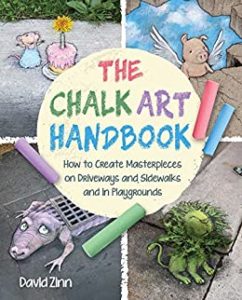A Trio of Non-Fiction in Teen



The Chalk Art Handbook: How to Create Masterpieces on Driveways and Sidewalks and in Playgrounds by David Zinn
Everything You Need to Ace…in One Big Fat Notebook series, various authors
The LEGO Castle Book: Build Your Own Mini Medieval World by Jeff Friesen
It’s spring! Or, at least it finally feels like it. Flowers and trees and shrubs are blooming around town, and possibility is in the air. Here in the Library’s Teen Department, the latest crop of books has as much variety and promise as the flowers outside. Take a look at these non-fiction titles just waiting to be discovered!
For middle school and high school students who are wrapping up the semester and preparing for finals, try a title in the Everything You Need to Ace…in One Big Fat Notebook series from Workman Publishing. Created by the editors of the popular educational game Brain Quest and written by authors with experience in the given field, each book is like borrowing the notes of the organized, thorough student in class.
Each title in the series breaks down key concepts into important, easily understood components covering the subject. The books are laid out like school notebooks with lined pages, handwritten fonts, and color-coded highlighted sections. Doodles illustrating complex topics are scattered throughout as are mnemonic devices, definitions of key terms, and quizzes for review. Compact-yet-thick, these titles easily fit into a backpack and are far easier to carry than most textbooks.
Disclaimer: the Big Fat Notebook series, while an amazing resource, is not a substitute for actually paying attention in class! It is fantastic for review, confidence building, and reinforcement of concepts before exams or in smaller bites during the semester. The series covers major subjects–computer science/coding, math, science, world history, American history, English language arts for middle school and pre-algebra/algebra 1, chemistry, biology, and geometry for high school. They are super helpful and accessible, great for middle school and high school students plus adults wanting to catch up on these subjects. (Where were these when I was in eighth-grade algebra?!)
To let off steam after studying, break out some LEGOs and try The LEGO Castle Book: Build Your Own Mini Medieval World by Jeff Friesen. Written for LEGO enthusiasts, this straightforward, concise title begins with a history of castles and a tour of their architecture then moves to building different types of castles and landscaping a medieval village from LEGOs, ending with instructions for 6 “master builds” (even a dragon).
The book’s layout is clean and clear, with color photos of completed and in-progress builds throughout. The brief text provides just the right amount of context for background; text in the builds sections is designed to look like manuals from LEGO sets, showing important phases along the way. Builds and book are designed for LEGO fans with some experience plus access to the variety of bricks listed (a few specialty ones). I was pleased to see a quick guide to the variety of bricks used (including color photographs showing individual bricks/plates with their official numbers) and a discussion of economical sources for purchasing the bricks needed.
Also, I was excited that the builds were grounded in history. Author Jeff Friesen identifies major types of medieval (European) castles with photos of completed LEGO versions and interesting text. He also depicts the main parts of the castle and the community within its walls and how to construct them, tossing in handy tips along the way such as using minifigure accessories as turret finials. He reminds readers that castle life was real life a thousand years ago, discussing topics like the role of castle builders, the cost and building process, and how castle architecture is tied to its defense. The LEGO Castle Book is great for teens, adults, or upper elementary ages with a passion for LEGO; pair this with David Macaulay’s classic Castle for a fantastic dive into the subject.
Looking for a different creative outlet? Try The Chalk Art Handbook: How to Create Masterpieces on Driveways and Sidewalks and in Playgrounds by David Zinn for some outdoor fun. Zinn has been creating delightful, amusing chalk drawings around his Michigan hometown for years and shares his enthusiasm and expertise in this guide to accessible outdoor art.
Zinn’s tone is warm and encouraging with a light sprinkling of dad humor. He offers basic techniques and advice for drawing 2-D and 3-D illustrations on outdoor surfaces such as concrete, asphalt, and brick. Viewing this art form as both an opportunity to stretch skills and to bring joy to the community, he emphasizes a respectful approach (ask permission, use media that will wash away, etc.). Color photos of his completed and in-process artwork illustrate his tips and techniques. His advice is concrete (no pun intended) and accessible although geared toward teens who have some drawing experience and skill. He assumes a base level of drawing knowledge which could be frustrating for someone trying it for the first time.
He invites artists to consider basic creative components before starting–what will you draw? How many? How will your creature(s) move around? What is happening in the picture? Then he moves to more detailed information about dealing with the drawing surface at hand. Zinn identifies various paved surfaces (concrete, macadam, paving stones, etc.) giving hints about turning their natural, imperfect states into part of the picture–pits and holes in concrete become the eyes and ears and nostrils of a hippo, a manhole cover becomes a cookie about to be eaten by a monster. As he notes, art tells a story, and depicting emotion is key even if it’s a small component, “Eyebrows are powerful things. Always use them wisely, both in your drawings and on your own face.”
The Chalk Art Handbook is packed with tips for creating whimsical, thoughtful drawings to delight artist and neighborhood alike. It serves as encouragement and inspiration to teens with drawing experience and/or an interest in sidewalk art, including 3-D illusion pictures. Everybody can win when public art is shared because “More art in more places brings more people more joy”.
Stop by the Library for these and many more titles blooming this spring!

